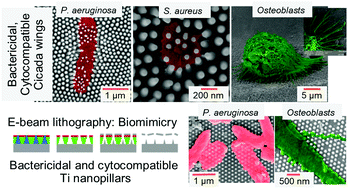Multi-biofunctional properties of three species of cicada wings and biomimetic fabrication of nanopatterned titanium pillars†
Abstract
Recently, multi-biofunctional properties of cicada wings have drawn keen interest for biomedical device applications due to their superhydrophobic, self-cleaning and bactericidal effects. We present a systematic evaluation of bactericidal and cytocompatible properties of cicada wings. We also present biomimetic nanofabrication of a patterned array of titanium nanopillars using electron beam lithography. We have characterized the nanoscale architecture of the wings of three different Australian species of cicadas (Psaltoda claripennis, Aleeta curvicosta and Palapsalta eyrei) using helium ion microscopy (HIM), scanning electron microscopy, atomic force measurement (AFM) and transmission electron microscopy (TEM). The chemical nature of the nanopatterned substrates was investigated using Fourier transform infrared spectroscopy (FTIR) and X-ray photoelectron spectroscopy (XPS). Pseudomonas aeruginosa and Staphylococcus aureus cells were attached to determine the bactericidal activity of the insect wings. Human osteoblast cells were attached to examine the biocompatibility of the insect wings. It was found that all the three cicada species have unique surface topography on their wing membranes and veins. The height, spacing, diameter, density and aspect ratio of the three species varied between the species and between the membrane and the veins. The density and aspect ratio of the nanopillars on the membranes were significantly higher than on the veins. Bacterial attachment investigation confirmed that P. aeruginosa cells and S. aureus cells were damaged by the nanopatterned array of pillars. A significant reduction in colonies of P. aeruginosa cells was found on the wings of the three species compared to the control after 18 hours. A significant reduction of S. aureus cells on the wings was observed at 2 and 4 hours but not at 18 hours compared to the control. The cell morphology of the human osteoblast cells appeared intact after 24 hours of attachment, indicating the biocompatibility of the insect wings. As a proof of concept, patterned nanopillars of titanium have been fabricated using the electron beam lithography technique directly inspired by the cicada wing architecture. The titanium nanopillars were observed to damage the bacterial cells of P. aeruginosa in a manner similar to the cicada wing species and remain compatible to osteoblast cells. The outcomes of this research can help to engineer an optimum nano-patterned surface to enhance the bioactivity and bactericidal effect on biomedical devices.



 Please wait while we load your content...
Please wait while we load your content...